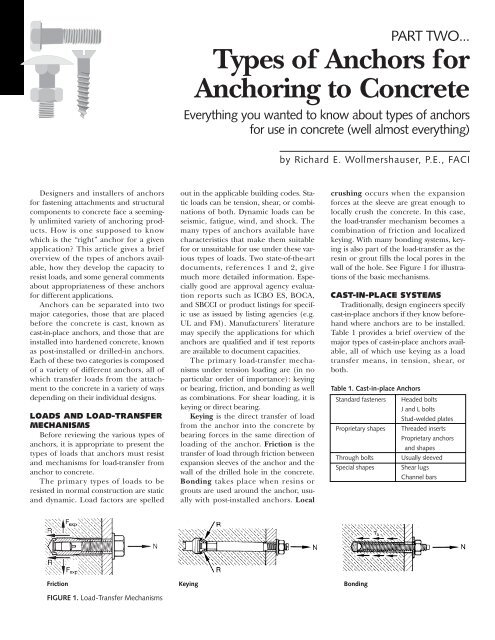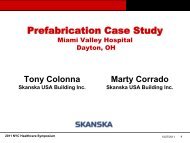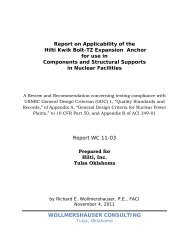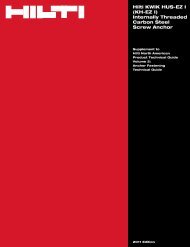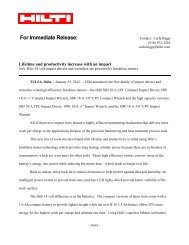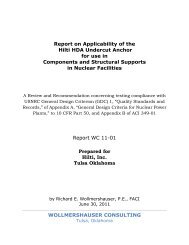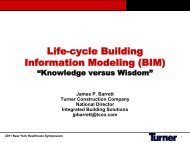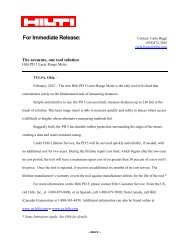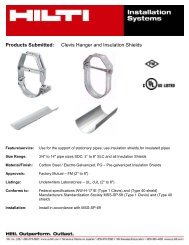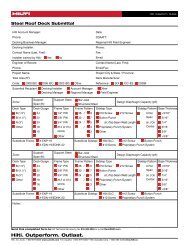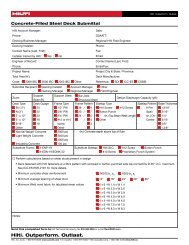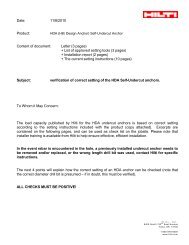Types of Anchors for Anchoring to Concrete - Hilti
Types of Anchors for Anchoring to Concrete - Hilti
Types of Anchors for Anchoring to Concrete - Hilti
You also want an ePaper? Increase the reach of your titles
YUMPU automatically turns print PDFs into web optimized ePapers that Google loves.
PART TWO...<br />
<strong>Types</strong> <strong>of</strong> <strong>Anchors</strong> <strong>for</strong><br />
<strong>Anchoring</strong> <strong>to</strong> <strong>Concrete</strong><br />
Everything you wanted <strong>to</strong> know about types <strong>of</strong> anchors<br />
<strong>for</strong> use in concrete (well almost everything)<br />
by Richard E. Wollmershauser, P.E., FACI<br />
Designers and installers <strong>of</strong> anchors<br />
<strong>for</strong> fastening attachments and structural<br />
components <strong>to</strong> concrete face a seemingly<br />
unlimited variety <strong>of</strong> anchoring products.<br />
How is one supposed <strong>to</strong> know<br />
which is the “right” anchor <strong>for</strong> a given<br />
application? This article gives a brief<br />
overview <strong>of</strong> the types <strong>of</strong> anchors available,<br />
how they develop the capacity <strong>to</strong><br />
resist loads, and some general comments<br />
about appropriateness <strong>of</strong> these anchors<br />
<strong>for</strong> different applications.<br />
<strong>Anchors</strong> can be separated in<strong>to</strong> two<br />
major categories, those that are placed<br />
be<strong>for</strong>e the concrete is cast, known as<br />
cast-in-place anchors, and those that are<br />
installed in<strong>to</strong> hardened concrete, known<br />
as post-installed or drilled-in anchors.<br />
Each <strong>of</strong> these two categories is composed<br />
<strong>of</strong> a variety <strong>of</strong> different anchors, all <strong>of</strong><br />
which transfer loads from the attachment<br />
<strong>to</strong> the concrete in a variety <strong>of</strong> ways<br />
depending on their individual designs.<br />
LOADS AND LOAD-TRANSFER<br />
MECHANISMS<br />
Be<strong>for</strong>e reviewing the various types <strong>of</strong><br />
anchors, it is appropriate <strong>to</strong> present the<br />
types <strong>of</strong> loads that anchors must resist<br />
and mechanisms <strong>for</strong> load-transfer from<br />
anchor <strong>to</strong> concrete.<br />
The primary types <strong>of</strong> loads <strong>to</strong> be<br />
resisted in normal construction are static<br />
and dynamic. Load fac<strong>to</strong>rs are spelled<br />
out in the applicable building codes. Static<br />
loads can be tension, shear, or combinations<br />
<strong>of</strong> both. Dynamic loads can be<br />
seismic, fatigue, wind, and shock. The<br />
many types <strong>of</strong> anchors available have<br />
characteristics that make them suitable<br />
<strong>for</strong> or unsuitable <strong>for</strong> use under these various<br />
types <strong>of</strong> loads. Two state-<strong>of</strong>-the-art<br />
documents, references 1 and 2, give<br />
much more detailed in<strong>for</strong>mation. Especially<br />
good are approval agency evaluation<br />
reports such as ICBO ES, BOCA,<br />
and SBCCI or product listings <strong>for</strong> specific<br />
use as issued by listing agencies (e.g.<br />
UL and FM). Manufacturers’ literature<br />
may specify the applications <strong>for</strong> which<br />
anchors are qualified and if test reports<br />
are available <strong>to</strong> document capacities.<br />
The primary load-transfer mechanisms<br />
under tension loading are (in no<br />
particular order <strong>of</strong> importance): keying<br />
or bearing, friction, and bonding as well<br />
as combinations. For shear loading, it is<br />
keying or direct bearing.<br />
Keying is the direct transfer <strong>of</strong> load<br />
from the anchor in<strong>to</strong> the concrete by<br />
bearing <strong>for</strong>ces in the same direction <strong>of</strong><br />
loading <strong>of</strong> the anchor. Friction is the<br />
transfer <strong>of</strong> load through friction between<br />
expansion sleeves <strong>of</strong> the anchor and the<br />
wall <strong>of</strong> the drilled hole in the concrete.<br />
Bonding takes place when resins or<br />
grouts are used around the anchor, usually<br />
with post-installed anchors. Local<br />
crushing occurs when the expansion<br />
<strong>for</strong>ces at the sleeve are great enough <strong>to</strong><br />
locally crush the concrete. In this case,<br />
the load-transfer mechanism becomes a<br />
combination <strong>of</strong> friction and localized<br />
keying. With many bonding systems, keying<br />
is also part <strong>of</strong> the load-transfer as the<br />
resin or grout fills the local pores in the<br />
wall <strong>of</strong> the hole. See Figure 1 <strong>for</strong> illustrations<br />
<strong>of</strong> the basic mechanisms.<br />
CAST-IN-PLACE SYSTEMS<br />
Traditionally, design engineers specify<br />
cast-in-place anchors if they know be<strong>for</strong>ehand<br />
where anchors are <strong>to</strong> be installed.<br />
Table 1 provides a brief overview <strong>of</strong> the<br />
major types <strong>of</strong> cast-in-place anchors available,<br />
all <strong>of</strong> which use keying as a load<br />
transfer means, in tension, shear, or<br />
both.<br />
Table 1. Cast-in-place <strong>Anchors</strong><br />
Standard fasteners Headed bolts<br />
J and L bolts<br />
Stud-welded plates<br />
Proprietary shapes Threaded inserts<br />
Proprietary anchors<br />
and shapes<br />
Through bolts Usually sleeved<br />
Special shapes Shear lugs<br />
Channel bars<br />
Friction Keying Bonding<br />
FIGURE 1. Load-Transfer Mechanisms
1.5<br />
Traditionally, design<br />
engineers specify<br />
cast-in-place anchors if<br />
they know be<strong>for</strong>ehand<br />
where anchors are <strong>to</strong><br />
be installed.<br />
Headed Bolt L-Bolt J-Bolt Stud-welded Plate<br />
FIGURE 2. Cast-in-place <strong>Anchors</strong><br />
Many <strong>of</strong> these types <strong>of</strong> anchors have<br />
special uses. Shear lugs and stud-welded<br />
plates provide large shear resistance,<br />
while channel bars give specific attachment<br />
capability. J and L bolts are typically<br />
used <strong>for</strong> anchoring sill plates <strong>to</strong><br />
foundations, but have a tendency <strong>to</strong><br />
straighten and pull out under high tension<br />
loading. Headed bolts under<br />
ASTM A 490 and F 1554 specifications<br />
are veritable workhorses <strong>for</strong> structural<br />
engineers.<br />
But what if the cast-in-place anchor is<br />
mislocated, or if the location <strong>of</strong> the<br />
anchor is not known be<strong>for</strong>e construction,<br />
or additional anchorages need <strong>to</strong><br />
be made after the concrete is cast? The<br />
post-installed anchor industry has developed<br />
a wide variety <strong>of</strong> products <strong>for</strong> these<br />
situations.<br />
POST-INSTALLED ANCHORS<br />
With the development and improvements<br />
<strong>of</strong> rotary hammer drills and carbide-tipped<br />
bits, the user has the<br />
capability <strong>to</strong> install many different kinds<br />
<strong>of</strong> post-installed anchors in hardened<br />
concrete virtually anywhere that is accessible<br />
<strong>to</strong> the drills.<br />
Post-installed anchors can be divided<br />
in<strong>to</strong> two major types, depending on the<br />
method <strong>of</strong> transferring load in<strong>to</strong> the<br />
concrete. They are mechanical systems<br />
and bonded or adhesive systems.<br />
<strong>Anchors</strong> can also be cross-classified<br />
according <strong>to</strong> their load carrying capability;<br />
heavy-duty, medium-duty and lightduty.<br />
Table 2 provides an overview <strong>of</strong> the<br />
major types <strong>of</strong> post-installed anchors currently<br />
available as well as a generalized<br />
load categorization.<br />
Table 2. Post-Installed <strong>Anchors</strong><br />
MECHANICAL SYSTEMS HEAVY- MEDIUM- LIGHT-<br />
DUTY DUTY DUTY<br />
Undercut <strong>Anchors</strong><br />
•<br />
Torque-controlled expansion anchors<br />
Heavy duty sleeve anchor • •<br />
Wedge anchors • • x<br />
Coil anchors • • x<br />
Screw anchors • • •<br />
Sleeve anchors • •<br />
Light duty metal anchors<br />
•<br />
Plastic anchors<br />
•<br />
Displacement-controlled expansion anchors<br />
Drop-in x • x<br />
Self-drilling x • x<br />
BONDED OR ADHESIVE SYSTEMS<br />
Using threaded rods or rein<strong>for</strong>cing bars<br />
Capsule systems • • x<br />
Cartridge systems • • x<br />
Bulk-injection systems • • x<br />
Cemetitious or epoxy grouted systems • • x<br />
• Indicates normal category<br />
x Indicates possible but not primary category<br />
MECHANICAL<br />
ANCHORING SYSTEMS<br />
While mechanical anchors have been<br />
available <strong>for</strong> several decades, there have<br />
been significant advances in the types<br />
and capabilities <strong>of</strong> these systems. They<br />
cover the range from heavy duty <strong>to</strong> light<br />
duty capacities. The major concern is <strong>to</strong><br />
select the appropriate anchors that will<br />
resist the expected loads <strong>for</strong> the given<br />
application. Is the anchor expected <strong>to</strong><br />
experience seismic or fatigue loads, or<br />
merely static loads? While some anchors<br />
will withstand all <strong>of</strong> these types <strong>of</strong> loads,<br />
others may fail abruptly under dynamic<br />
loading at a load level less than the static<br />
capacity.<br />
■ UNDERCUT ANCHORS<br />
These anchors have been on the market<br />
<strong>for</strong> about 20 years. They are excellent<br />
<strong>for</strong> use under both static and<br />
dynamic loads. They obtain their holding<br />
capacity through keying, that is,<br />
direct bearing on the concrete, and,<br />
under proper installation, can withstand<br />
very high loads without slipping out <strong>of</strong><br />
the drilled hole. They are the preferred<br />
anchors <strong>for</strong> use where cracks in tension<br />
zones <strong>of</strong> the concrete can be expected <strong>to</strong><br />
occur.
■ EXPANSION ANCHORS<br />
Expansion anchors have been available<br />
<strong>for</strong> at least 30 years. There are two<br />
basic types that are distinguished by their<br />
operating principles. The first, <strong>to</strong>rquecontrolled<br />
expansion anchors, are<br />
installed by inserting the anchor in<strong>to</strong> the<br />
drilled hole, and applying the prescribed<br />
setting <strong>to</strong>rque <strong>to</strong> the head or nut. A cone<br />
at the bot<strong>to</strong>m <strong>of</strong> the anchor is pulled up<br />
in<strong>to</strong> an expansion sleeve that expands<br />
in<strong>to</strong> the concrete with local crushing,<br />
and providing both friction and localized<br />
keying as load-transfer mechanisms.<br />
Most have a beneficial follow-up expansion<br />
characteristic that under tension<br />
loading, the more the anchor bolt displaces<br />
upward out <strong>of</strong> the hole, the<br />
greater the expansion <strong>for</strong>ces.<br />
There are several types available that<br />
vary significantly in their ability <strong>to</strong> resist<br />
static and dynamic loads. The heavy-duty<br />
sleeve anchor (not <strong>to</strong> be confused with<br />
the light duty sleeve anchor composed <strong>of</strong><br />
a sheet metal sleeve around a cone) can<br />
resist dynamic loads as well as function<br />
well in expected cracks in concrete.<br />
Wedge anchors are the most common<br />
type <strong>of</strong> <strong>to</strong>rque-controlled expansion<br />
anchor. Many have been tested <strong>for</strong> resisting<br />
seismic loads and have received<br />
ICBO ES Evaluation Report listings <strong>for</strong><br />
such service.<br />
Sleeve anchors are generally considered<br />
light duty, and rely more on friction<br />
and less on local crushing and keying <strong>of</strong><br />
the concrete. They can be used in hollow<br />
masonry.<br />
The second major type <strong>of</strong> expansion<br />
anchor is the displacement-controlled<br />
expansion anchor. Two primary examples<br />
are the drop-in and the self-driller.<br />
Drop-in anchors are installed in the<br />
predrilled hole by use <strong>of</strong> a setting <strong>to</strong>ol<br />
that drives a plug in<strong>to</strong> the expansion<br />
portion <strong>of</strong> the anchor. The lower section<br />
<strong>of</strong> the anchor is expanded in<strong>to</strong> the concrete,<br />
which experiences local crushing.<br />
The second type has cutting teeth on the<br />
lower end and drills its own hole. The<br />
anchor is driven on<strong>to</strong> an expansion plug<br />
that expands the lower portion <strong>of</strong> the<br />
anchor in<strong>to</strong> the concrete. These anchors<br />
derive their holding capacity from friction<br />
and keying. The drawback is that<br />
they do not have any follow-up expansion.<br />
Once set, they do not expand further<br />
under loading. If the plug is not<br />
Sleeve Anchor<br />
FIGURE 3. Mechanical <strong>Anchors</strong><br />
Torque-controlled<br />
Expansion Anchor<br />
sufficiently set, the anchor may experience<br />
reduced capacity.<br />
■ OTHER TYPES OF<br />
MECHANICAL ANCHORS<br />
Screw anchors <strong>of</strong> smaller diameters<br />
and used <strong>for</strong> light duty applications have<br />
been available <strong>for</strong> many years. They are<br />
installed in<strong>to</strong> holes drilled with matched<strong>to</strong>lerance<br />
bits. Recently, manufacturers<br />
have been introducing larger diameter<br />
screw anchors in the heavy-duty range,<br />
either installed in<strong>to</strong> holes drilled with<br />
matched-<strong>to</strong>lerance bits or using bits<br />
meeting the requirements <strong>of</strong> ANSI<br />
B212.15. They distribute the load in<strong>to</strong><br />
the concrete through load transfer from<br />
the threads <strong>to</strong> the concrete (keying).<br />
Coil anchors have also been introduced<br />
in<strong>to</strong> the market in the heavy-duty<br />
Heavy-duty<br />
Sleeve Anchor<br />
Undercut<br />
Anchor<br />
Drop-in Anchor Self-drilling Anchor Stud Anchor<br />
FIGURE 4. Displacement-controlled Expansion <strong>Anchors</strong><br />
load range. A coil anchor is composed <strong>of</strong><br />
a coil near the end <strong>of</strong> a specially<br />
designed lag bolt. As the bolt is <strong>to</strong>rqued,<br />
the screw advances through the coil,<br />
which expands in<strong>to</strong> the concrete. High<br />
load capacities can be developed.<br />
■ LIGHT DUTY ANCHORS<br />
There are many light duty anchors<br />
available, made <strong>of</strong> metals and plastics.<br />
They function in a variety <strong>of</strong> base materials,<br />
concrete, masonry, wood, drywall,<br />
etc. Manufacturers publish test data <strong>to</strong><br />
document their capacities in these base<br />
materials.<br />
BONDED ANCHOR SYSTEMS<br />
Bonded resin or adhesive anchors<br />
were generally introduced in<strong>to</strong> the construction<br />
market about twenty years ago.
Bonded systems use a combination <strong>of</strong><br />
adhesive bond and micro keying in<strong>to</strong> the<br />
pores <strong>of</strong> the concrete. Early systems used<br />
polyester resin, epoxies, and later, vinyl<br />
ester resins. In recent years, a larger variety<br />
<strong>of</strong> resins have been developed that<br />
have individual advantages, such as use<br />
in high temperatures, low temperatures,<br />
damp and wet holes, etc. For two component<br />
epoxy systems, the ratio <strong>of</strong> hardener<br />
<strong>to</strong> resin is critical. Prepackaged<br />
cartridge systems assure that the proper<br />
mixing is obtained. While a variety <strong>of</strong><br />
installation methods are used, most are<br />
two component resin systems that<br />
anchor threaded rod in<strong>to</strong> predrilled<br />
holes. Most will resist dynamic loads,<br />
both seismic and fatigue, but documentation<br />
in the <strong>for</strong>m <strong>of</strong> test reports should<br />
be obtained. Bonded or adhesive<br />
anchoring systems are not well suited <strong>for</strong><br />
cracked tensile zones <strong>of</strong> concrete since<br />
about 1/2 the bonding is lost, unless one<br />
uses special anchoring systems developed<br />
<strong>for</strong> use in cracked concrete. One<br />
should also use the recommended drill<br />
bit size, since many <strong>of</strong> the adhesives are<br />
sensitive <strong>to</strong> the size <strong>of</strong> the gap between<br />
the anchor rod and the concrete.<br />
■ CAPSULE SYSTEMS<br />
The original capsules were made <strong>of</strong><br />
glass, with an internal glass capsule that<br />
contained the hardener. Recent versions<br />
use plastic foil instead <strong>of</strong> the glass capsules.<br />
The capsule is inserted in<strong>to</strong> the<br />
hole. The threaded rod or rein<strong>for</strong>cing<br />
bar is then rotary-hammered in<strong>to</strong> the<br />
glass capsule, breaking the glass and mixing<br />
the resin and hardener. Capsule<br />
anchors provide very good bonding as<br />
the rotary mixing action wipes and<br />
cleans the surface <strong>of</strong> the hole, allowing<br />
the adhesive <strong>to</strong> bond well.<br />
■ CARTRIDGE SYSTEMS<br />
Introduced also about 20 years ago,<br />
cartridge systems are the most popular<br />
delivery method since they are also the<br />
most versatile. The resin and hardener<br />
are packaged in separate but connected<br />
side-by-side plastic or foil tubes. A mixing<br />
nozzle is placed on the end <strong>of</strong> the tubes<br />
and the resin and hardener dispensed by<br />
a hand operated or a pneumatic dispenser.<br />
Also used <strong>for</strong> heavy-duty applications,<br />
hole cleaning is very critical since<br />
dust on the concrete hole surface limits<br />
the bond and micro keying.<br />
■ BULK INJECTION SYSTEMS<br />
For high volume applications such as<br />
highway contracts or large building<br />
where repetitive installation <strong>of</strong> anchors is<br />
required, bulk mechanical and hydraulic<br />
dispensing systems are available. Attention<br />
<strong>to</strong> the proper mixing ratio <strong>for</strong> epoxy<br />
resins is critical since bulk equipment<br />
can go “<strong>of</strong>f ratio.”<br />
■ GROUTED SYSTEMS<br />
Predating resin systems are cemetitious<br />
grouts. There are a variety <strong>of</strong> proprietary<br />
systems available. Non-shrink or<br />
slightly expansive grouts are preferred <strong>to</strong><br />
prevent shrinkage and lack <strong>of</strong> bonding<br />
<strong>to</strong> the existing concrete.<br />
IN SUMMARY…<br />
A wide variety <strong>of</strong> anchoring systems<br />
are available. The correct selection<br />
depends on several fac<strong>to</strong>rs, including<br />
types <strong>of</strong> loads <strong>to</strong> be resisted, magnitude<br />
<strong>of</strong> the load, type <strong>of</strong> base material (concrete<br />
or masonry), and environment<br />
conditions (damp, wet, dry), among others.<br />
The manufacturers’ literature provides<br />
a good starting place, but also look<br />
<strong>for</strong> evaluation reports and product listings,<br />
since they may be required under<br />
many building codes. ■<br />
REFERENCES<br />
1. State-<strong>of</strong>-the-Art Report on Anchorage <strong>to</strong><br />
<strong>Concrete</strong> ACI 355.1R-91, American<br />
<strong>Concrete</strong> Institute, Detroit, 1991.<br />
2. Fastenings <strong>to</strong> <strong>Concrete</strong> and Masonry<br />
Structures; State <strong>of</strong> the Art Report,<br />
Comité Euro-Intérnational du Bé<strong>to</strong>n,<br />
Thomas Tel<strong>for</strong>d Services Ltd., London,<br />
1994.<br />
3. ANSI B212.15-1994, American National<br />
Standard <strong>for</strong> Cutting Tools—Carbide-<br />
Tipped Masonry Drills and Blanks <strong>for</strong><br />
Carbide-Tipped Masonry Drills, American<br />
National Standards Institute, New<br />
York, N. Y., 10 pp.<br />
Richard Wollmershauser is Direc<strong>to</strong>r Technical<br />
Services <strong>for</strong> <strong>Hilti</strong>, Inc. <strong>of</strong> Tulsa,<br />
Oklahoma. He has been active in the concrete<br />
anchor industry <strong>for</strong> the past 20 years.<br />
He is a registered PE in Ohio and<br />
Oklahoma and a Fellow <strong>of</strong> the American<br />
<strong>Concrete</strong> Institute. He currently serves as<br />
Vice-President <strong>of</strong> CAMA, The <strong>Concrete</strong><br />
Anchor Manufactures Association, Chairman<br />
<strong>of</strong> ASTM Subcommittee E06.13,<br />
Per<strong>for</strong>mance <strong>of</strong> Connections in Building<br />
Construction, and just completed 7 years as<br />
Chairman <strong>of</strong> the American <strong>Concrete</strong><br />
Institute Committee 355, Anchorage <strong>to</strong><br />
<strong>Concrete</strong>. He was edi<strong>to</strong>r <strong>of</strong> the ACI State-<strong>of</strong>the-Report<br />
on Anchorage <strong>to</strong> <strong>Concrete</strong> (ACI<br />
355R1-93). He also serves on the Federation<br />
International du Be<strong>to</strong>n Task Group<br />
SAG 4 Fastening <strong>to</strong> <strong>Concrete</strong> and Masonry.<br />
He served on three committees <strong>of</strong> the recent<br />
NEHRP 2000 Seismic Provisions Update<br />
program where he was concerned with the<br />
introduction <strong>of</strong> anchoring design methods.<br />
Adhesive Capsule<br />
Anchor<br />
Adhesive Cartridge<br />
System<br />
FIGURE 5. Adhesive Bonded Anchor Systems


